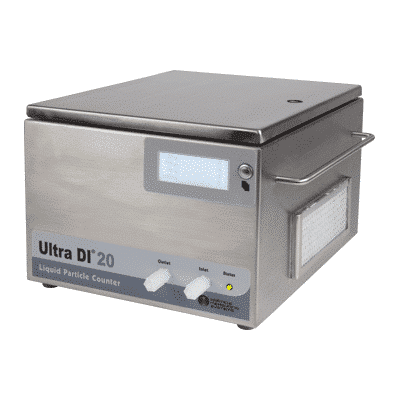20 nm v. 50 nm Nanoparticles
Monitoring nanoparticles in ultrapure water (UPW) systems using the legacy standard of 50 nm sensitivity has been effective and efficient for the last ten years. Assessing particle counts at 50 nm is commonly used for benchmarking UPW cleanliness, including the Ultra DI® 50 Liquid Particle Counter from Particle Measuring Systems. UPW is used in critical applications, primarily for washing and removing particulates from the surfaces of products and as dilution for chemicals used for different processes in many electronics industries. The cleanliness of the UPW is critical to achieving optimal particulate removal. The enhancement of ultra-filter performance down to sub-nanoparticle filtration capability routinely produce zero or very close to zero particle counts at 50 nm for most of the advanced UPW in use today. In recent years, the emphasis on particle reduction at smaller sizes (less than 50 nm) evolved due to technology advancement with tightening of semiconductor product quality requirements and shrinking design dimensions to pack more transistors into a single chip. Monitoring UPW at 50 nm can no longer provide sufficient differentiation in particle performance between the best and good water systems. Semiconductor industry experts are currently investigating if the performance of sub-nanoparticle filtration can be accurately determined using a 50 nm particle counter, or if reducing the sensitivity of the measurement will provide better evidence of the filtration’s capability to remove nanoparticles.

Semiconductor industry leaders have emphasized the importance of understanding nanoparticle contamination in ultrapure water (UPW) production and distribution. They have explored the advantage of monitoring particle baseline at 20 nm over the existing 50 nm particle performance of the state-of-art UPW system. Many interesting investigations on this space pivot around the motivations to study the value of monitoring particle size down to 20 nm at the UPW system, including the Ultra DI® 20 Liquid Particle Counter from Particle Measuring Systems. The objective of looking into this aspect opens various opportunities for better enhancement in particle monitoring and practical use. This application note illustrates various case studies of monitoring methods used in advanced UPW systems. It investigates whether detecting down to 20 nm could add value to the legacy monitoring standard at 50 nm.
Interested in learning more? Complete the form here to receive expert consultation.
